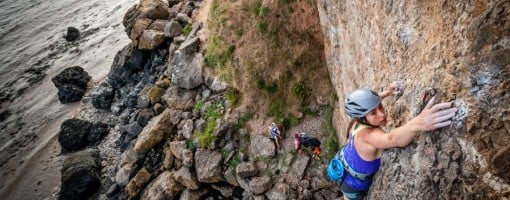
Climbs 110
Rocktype Limestone
Altitude 16m a.s.l
Faces S
Lucia working Coral Sea © Ben.o.neill
Crag features
A South-facing limestone sea cliff with two distinct characters; a very popular section of mainly harder sports routes in the Boulder Cove on generally good rock contrasts with a long line of rarely climbed trad routes on variable quality rock.
The National Trust owns Brean Down and asks climbers to avoid the sand 'cliff' and the rocks adjacent to it, where archaeological finds have been discovered recently.
Approach notes
From the A38 or M5 jct 22, take the B3140 to Burham-On-Sea and Berrow from where a minor road runs northwards to a dead end with a NT carpark and café. The NT carpark opens at 10am but the exit remains open allowing you to leave at any time. Two other carparks close by open earlier but also lock their gates earlier.
The whole crag is tidal with one of the fastest and largest tidal ranges in the world. The height of the tide determies specific access times but generally the base of the cliff will be accessable except within a maximum of two hours either side of high tide.
Access across the beach to the most popular section, the Boulder Cove is affected by the tide more than the climbing itself. Access wise you will be able to get in/out 1-2 hours either side of high tide depending on the height of the tide. Climbing wise, generally you can climb at high tide although tides above 12m will cover the beach side of the cove but the upper level is well above the tide line.
Access to the Boulder Cove sport routes is still possible when the tide cuts off the beach approach via an exposed route in over the top. This is equipped with a fixed hand line but this should be treated with caution. The anchors available for the middle section are not directly above the descent line. When approached from below the rope for the middle section can get caught in the scrub. When the grass is wet the approach becomes more serious. The route is diificult to find from above so it is best to familiarise yourself from from the bottom first.
|
Climbs at this crag
| Name | Grade | Stars | Type | Logs | Partner Ascents |
|---|
These climbs you have climbed by seconding or top-roping.
These climbs you have Dogged.
These climbs you Did not Finish.
Climbs are waiting to be checked by a crag moderator, and may not be accurate. Climbs can't be verified by a crag moderator, and they need more information to confirm it. Climbs are no longer climbable.
Moderators Updates to this page are checked by UKC volunteers sam.sam.sam.ferguson and Wise